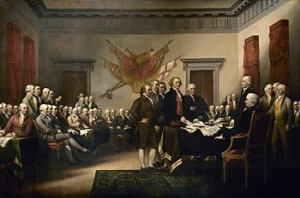Two hundred thirty-eight years ago this month, a group of highly intelligent and extremely articulate men met in Philadelphia as part of the Second Continental Congress. The weather was hot and muggy, there was no air-conditioning, not even a fan, and the doors and windows were sealed. Secrecy was of utmost importance for they were in the midst of creating a dynamic new form of government here in the New World.
The session began on June 7 when Richard Henry Lee presented what became known as the Lee Resolution, an expression of what was already beginning to happen throughout the American Colonies. Conditions between the colonies and Great Britain had deteriorated sharply in the past year. Committees of Safety were formed to communicate with other colonies. Men and women read works of noted philosophers throughout Europe mostly written since 1685 when the Enlightenment Movement began on the Continent.
Enlightenment Thinking or the Age of Reason questioned traditional political, scientific, and religious authority to conclude that humanity could be improved through rational change, brought about by rational questioning and progress through dialogue. Leaders in the Enlightenment movement included John Locke, Thomas Paine, Renee Descartes, Jean-Jacques Rousseau, Thomas Jefferson, Immanuel Kant, and Voltaire, all widely read essayists. Kant’s challenge, “Dare to Know! Have courage to use your own reason!” became the battle cry of the group.
On June 11, the Continental Congress recessed for three weeks after appointing a Committee of Five to draft a statement for the world to understand the colonies’ case for independence. Members of the committee included John Adams of Massachusetts, Roger Sherman of Connecticut, Benjamin Franklin of Philadelphia, Robert R. Livingston of New York, and Thomas Jefferson of Virginia. Ironically, Livingston did not sign the final copy, fearing the declaration was premature.
Between that date and June 28, 1776 three men on the committee drafted the most cherished symbol of American liberty, the Declaration of Independence. Thomas Jefferson is credited with writing the document with changes made by Franklin and Adams. Jefferson summarized Enlightenment philosophy in the “self-evident truths” part of the document.
On July 1, 1776, Congress reconvened. The following day the Lee Resolution for independence was adopted by 12 of the 13 colonies, with New York not voting. Immediately the group began discussion of the document created by the Committee of Five. Revision continued through the night of July 3 and into mid-morning of July 4. At last all church bells in Philadelphia rang out; the Declaration had been officially adopted. However, it would take five more days before the delegation from New York approved the document.
Without a doubt the Declaration of Independence is one of the most significant documents in world history. That it has stood the test of time for 238 years is amazing. Countless countries have used it as a basis for their governments, including the Republic of Texas. What a great treasure we will celebrate this coming week!
The National Archives has an interesting article on its web site. Go to http://www.archives.gov/exhibits/charters/declaration.html. Then enjoy your Fourth of July.

